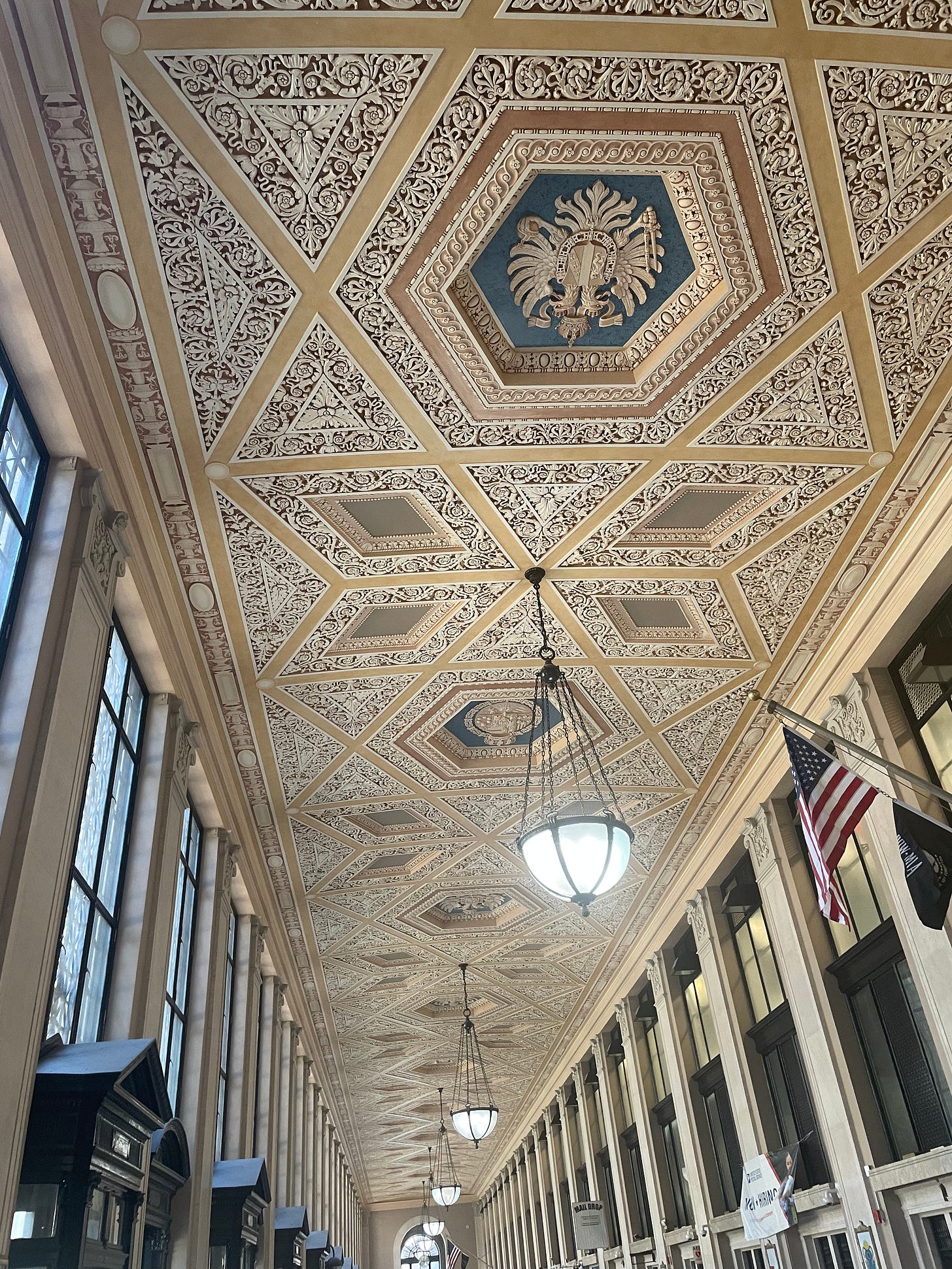Filler
Filling space and time for pleasure, profit, or just to buy a little time before the truth sets in - is it dangerous?
I was looking up at the ceiling of New York City’s main post office on 8th Avenue the other day, while I waited my turn. It’s a continuous intricate pattern of floral elaborations in molded plaster across a block-long surface.
And I thought “that’s how you do it.” Do what? Fill space. The ceiling is artful, but not exactly art. There’s no message in it. But it’s very pleasant. It gave my eyes something to do.
Why there’s not much to look at
The decorative arts have been in retreat since the first World War, when its chief proponents insisted on a mass slaughter that no one recalled fondly. The most visually engaging style to emerge afterwards was probably Art Deco, which had the bad luck to be popular with an even worse bunch of European powers, hindering everyone’s ability to enjoy it.
There might have been a successor style for buildings, especially public buildings, that people might have enjoyed. But something happened. I think it was television.
A different space to fill
Being private, television changed the way that people looked at the public world in a way that movies did not. Old movie theaters are among the most elaborate, visually interesting structures built in the 20th century.
But after television, there was a sudden disinterest in making physical reality something to look at in a meaningful way. It wasn’t ideological like Brutalism, or entirely cheapo, like the Seagram’s Building knockoffs in our nation’s urban downtowns. It was more that no one cared. Filling public space was less important because the seemingly private visual space would now fill our time. And fill time it does. People watch a lot of television.
Get it over with
The public space soon became less somewhere to be than somewhere in the way of returning to our private spaces. It was the dawn of get-it-over-with America, of highways and suburbs.
In New York, this shift is associated with Robert Moses, probably because New York is one of the few places in America developed thoroughly enough along different enough lines to have offered any resistance. Everywhere else, this get-it-over-with approach to public space is a given. It’s a lot of driving and a lot of television.
People may talk about walkable cities here and there, now and again. But they unfailingly bitch about parking.
Rococo buffet
The few times I’ve been to European cities, I was awestruck, scouring the cornices and decorative flourishes, devouring the fountains, the statues and so on and on and on. The world was flush with associations, tangling history, religion, myth to a very human core.
I realized how much of a bread-and-water visual diet I’d been on in America, even New York. The shiny new Amtrak waiting area behind the 8th Avenue post-office lobby is a fine example of visual starvation. The primary visual impulse seems to have been to build something that would be easy to clean.
The place has let’s-get-it-over-with written all over it.
But something happened to me after a while in the grand cities of Europe, especially in the more baroque places, which had overwhelmed me the first time I saw them. It was a feeling of exhaustion coupled with a suspicion. All that myth, history and religion, along with the incredible artistry and craftsmanship suddenly hit me wrong. It wasn’t so much a message as a filibuster of the imagination. It was filler, and almost in a sinister way. Sometimes the more you labor to fill a void, the more it comes into focus.
It left me with the harrowing sensation common to many ages but left largely unsaid that there's a lot less going on than it seems.
Identifying filler
Filler feels dangerous because we only have so much time and space. If there is a point, we ought to get to it, right?
Filler can be delightful, like that post office ceiling. It can be small talk, or lobby art, or Spotify playing in a restaurant. And that’s fine. Seductions often begin under other pretenses. Flirtation works when there’s filler to pierce with possible meaning.
Maybe just hanging out isn’t the point. If not, then the point - we often have reason to suspect - is best left alone.
The map room
When I was a freelancer, I had two kinds of work: By the hour and by the project. With an hourly rate, every disruption and delay is welcome. I was once paid a whole summer to just call in and be told to wait for more work. With a project, the best case scenario is to get it done very quickly, with as little feedback from the client as possible.
That experience underlined something a little surprising. My relationship to time isn’t a steady one. I kill time, but I need more time. I maximize my time to get to the place where I have time to enjoy.
How you feel about filler is a question of posture. Are you attacking your time? Are you enduring your time? In the map room of your personal war, are the arrows of the advancing armies pointed toward your capitol or away?
Shakespeare and soup kitchens
I go back and forth with Shakespeare. What gets me is that his plots are the weakest part - they’re mostly a frame for him to hang his poetry on. “There’s this king, and…” then he’s off to the races, making points, hitting homers, putting all kinds of crazy words in people’s mouths.
It’s like revenge of the filler. We just showed up at the theater to know if this princess or that duke gets busted for what they did. But hold up! The second retainer has to tell you the meaning of your meaningless life! And then the king gets killed, offstage, according to someone with exactly one line.
A lot of life is filler. I guess a lot of the people can feel that way too. Once in a while you meet someone serious, whose feet are really touching the real ground, and they’re on fire. They’re not filler, or they certainly don’t think they are. Often these people have jobs helping people, face to face, with their own hands.
They don’t usually love your wry remarks. They can be unsettling, especially when you’re full of shit, as I sometimes am. Shakespeare can be like meeting one of those serious guys at a school fundraising cocktail auction event.
Butter notes
Many years ago, I went to see bassist Al McKibbon play at Kevin Costner’s ex-wife’s restaurant in Pasadena. Between sets, I went up and said hello. He’d played with Thelonious Monk and Dizzy Gillespie, and told some funny stories. Thelonious went a whole European tour without saying a word to his fellow bandmates, except to say they were ugly motherfuckers, shortly before the plane touched down back in New York.
Al talked about lesser gigs on the way to that jazz brunch. One place hid asked him to play more spritely, and fired him when he asked for an explanation of what that meant. I remember he gestured to the brunchers at at Kevin Costner’s ex-wife’s restaurant in Pasadena, and referred to his work lately as auditory wallpaper, or filler.
Herbie Hancock, in an interview, told a story about when he’d just started playing with Miles. In the middle of a song, Miles told him top “stop playing the butter notes.” The two had never discussed what might possibly be meant by “butter notes.” Herbie was young and brilliant, and felt his way to the answer, apparently.
Everyone loves butter. Butter forgives inferior or past-due ingredients, and brings together flavors that don’t quite agree into concert. Maybe Miles knew the good stuff wasn’t in the butter, but in what comes into view once you remove all the easy answers. Maybe he was just fucking with the new guy.
Being definitive in art, or not
The interplay of filler and meaning is partly why so-called prestige television has gotten so lame - something meaningful has to happen, but not so meaningful that you can’t have another season.
There are works of art that could be considered a final word. Among Samurai, there are suicide poems. And there are plenty of great poets, novelists and artists who’ve murdered themselves (See “Does Suicide Discredit and Artist’s Works?” in June). It can feel a little off when you try to fill the time with their work.
Geometry of meaning
Think of your life as a shape. Nothing crazy, something two-dimensional on paper. The shape has corners. But it only has a finite number of corners. A shape with infinite corners is a circle, and you could just as easily describe it as having no corners at all.
Maybe your shape has six or fifteen corners - straightish lines of routine interrupted by sudden corners, followed by the next straightish line. There are meaningful events and filler.
Sometimes the quotidian lushness of life feels like filler, and you start to long for a meaningful interruption. Sometimes you wish the changes in trajectory would just please stop, so you can get back into a routine.
Is this filler?
Keep reading with a 7-day free trial
Subscribe to No Homework to keep reading this post and get 7 days of free access to the full post archives.



